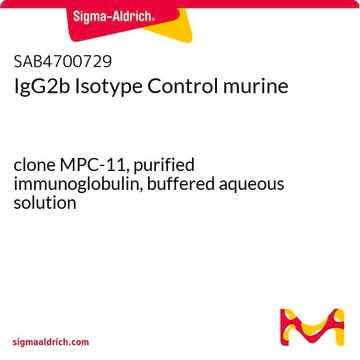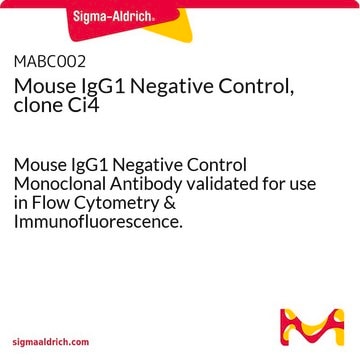MABC006
Mouse IgG2b Negative Control, clone GC198
Mouse IgG2b Negative Control Monoclonal Antibody validated for use in Flow Cytometry & Immunofluorescence.
Sign Into View Organizational & Contract Pricing
All Photos(1)
About This Item
UNSPSC Code:
12352203
eCl@ss:
32160702
NACRES:
NA.42
Recommended Products
biological source
mouse
Quality Level
antibody form
purified immunoglobulin
clone
GC198, monoclonal
manufacturer/tradename
Chemicon®
concentration
0.5 mg/mL
technique(s)
flow cytometry: suitable
immunofluorescence: suitable
isotype
IgG2b
shipped in
wet ice
target post-translational modification
unmodified
Specificity
This antibody reacts with the outer membrane protein of some strains of Neisseria gonorrhoeae. No reaction with human cell surface or plasma components has been observed. However, some binding to Fc receptors may occur.
Immunogen
Protein I preparation from Neisseria gonorrhoeae.
Application
Mouse IgG2b is a monoclonal antibody intended for use as a negative control in immunofluorescence, flow cytometry, and immunoperoxidase staining on frozen and paraffin tissue sections. Its use enables an estimation of non specific binding of mouse monoclonal antibodies to cell surface components in peripheral blood and tissue.
SUGGESTED USAGE
The control antibody should be diluted to the same concentration as the test antibody, and equivalent volumes used.
SUGGESTED USAGE
The control antibody should be diluted to the same concentration as the test antibody, and equivalent volumes used.
Research Category
Secondary & Control Antibodies
Epitope Tags & General Use
Secondary & Control Antibodies
Epitope Tags & General Use
Research Sub Category
Isotype Control Antibodies
Isotype Control Antibodies
Linkage
Replaces: CBL602
Physical form
Format: Purified
Purified immunoglobulin. The antibody is supplied in 0.5ml 25mM Tris-HCl, 0.4M NaCl, pH 8.0, containing 0.2% bovine serum albumin and 0.1% sodium azide. The characteristics of each lot are tested by electrophoresis, specific immunofluorescence assay and flow cytometry.
Storage and Stability
Store at 2 to 8°C, for up to 6 months. For prolonged periods, store below -20°C in undiluted aliquots. AVOID REPEATED FREEZE/THAW CYCLES.
WARNING: The monoclonal reagent solution contains 0.1% sodium azide as a preservative. Due to potential hazards arising from the build up of this material in pipes, spent reagent should be disposed of with liberal volumes of water.
WARNING: The monoclonal reagent solution contains 0.1% sodium azide as a preservative. Due to potential hazards arising from the build up of this material in pipes, spent reagent should be disposed of with liberal volumes of water.
Legal Information
CHEMICON is a registered trademark of Merck KGaA, Darmstadt, Germany
Disclaimer
Unless otherwise stated in our catalog or other company documentation accompanying the product(s), our products are intended for research use only and are not to be used for any other purpose, which includes but is not limited to, unauthorized commercial uses, in vitro diagnostic uses, ex vivo or in vivo therapeutic uses or any type of consumption or application to humans or animals.
Signal Word
Warning
Hazard Statements
Precautionary Statements
Hazard Classifications
Met. Corr. 1
Storage Class Code
8B - Non-combustible corrosive hazardous materials
WGK
WGK 2
Flash Point(F)
Not applicable
Flash Point(C)
Not applicable
Certificates of Analysis (COA)
Search for Certificates of Analysis (COA) by entering the products Lot/Batch Number. Lot and Batch Numbers can be found on a product’s label following the words ‘Lot’ or ‘Batch’.
Already Own This Product?
Find documentation for the products that you have recently purchased in the Document Library.
Joshua N Douglas et al.
Journal of neuroinflammation, 13(1), 178-178 (2016-07-09)
Neurodegeneration is believed to be the primary cause of permanent, long-term disability in patients with multiple sclerosis. The cause of neurodegeneration in multiple sclerosis appears to be multifactorial. One mechanism that has been implicated in the pathogenesis of neurodegeneration in
Victoria Karakis et al.
The Journal of biological chemistry, 299(5), 104650-104650 (2023-03-28)
Human trophoblast stem cells (hTSCs) have emerged as a powerful tool to model early placental development in vitro. Analogous to the epithelial cytotrophoblast in the placenta, hTSCs can differentiate into cells of the extravillous trophoblast (EVT) lineage or the multinucleate syncytiotrophoblast
Jennifer M Colón et al.
Journal of neurotrauma, 33(18), 1696-1708 (2016-02-21)
Spinal cord injury (SCI) is a condition with no available cure. The initial physical impact triggers a cascade of molecular and cellular events that generate a nonpermissive environment for cell survival and axonal regeneration. Spinal cord injured patients often arrive
Kristina Hopfensperger et al.
mBio, 11(4) (2020-07-16)
HLA-C-mediated antigen presentation induces the killing of human immunodeficiency virus (HIV)-infected CD4+ T cells by cytotoxic T lymphocytes (CTLs). To evade killing, many HIV-1 group M strains decrease HLA-C surface levels using their accessory protein Vpu. However, some HIV-1 group
Wells S Brown et al.
Cell reports. Medicine, 1(8), 100131-100131 (2020-12-10)
Activating KRAS mutations are found in over 90% of pancreatic ductal adenocarcinomas (PDACs), yet KRAS has remained a difficult target to inhibit pharmacologically. Here, we demonstrate, using several human and mouse models of PDACs, rapid acquisition of tumor resistance in
Our team of scientists has experience in all areas of research including Life Science, Material Science, Chemical Synthesis, Chromatography, Analytical and many others.
Contact Technical Service

![3-Aminoimidazo[1,2-a]pyridine 97%](/deepweb/assets/sigmaaldrich/product/structures/177/879/133fd1ee-499a-4242-9d3c-406e87ce1d6c/640/133fd1ee-499a-4242-9d3c-406e87ce1d6c.png)







